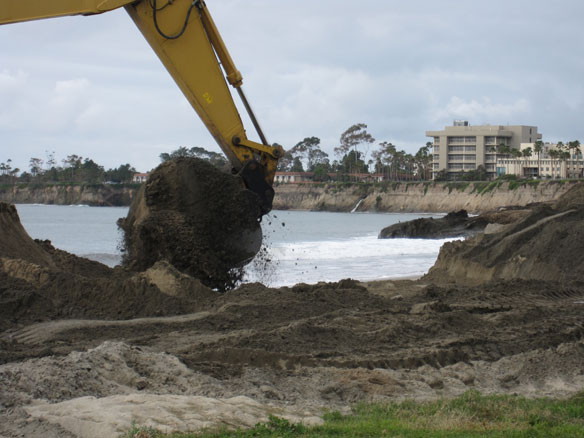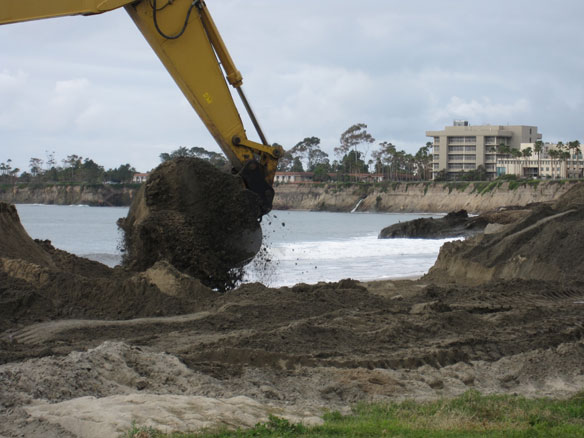
Photo source: © SAF — Coastal Care.
“The first beach nourishment project may have taken place more than 2,000 years ago when, according to legend, Roman leader Marc Antony had sand shipped from the Egyptian desert to a beach in Turkey so that his lover, Egyptian queen Cleopatra, would be able to step on soil from her homeland as she came ashore. The beach in Alanya, Turkey, is now known as Cleopatra’s Beach.” See Source
Excerpts;
A common approach to combatting erosion at U.S. coastlines is beach nourishment, which is literally taking sand from one place, often offshore, and pumping it onto a sand-depleted beach.
The question is, can beach nourishment keep up with the ever-increasing forces of climate change or, like Sisyphus forever pushing his boulder up the hill, is adding sand to beaches an expensive, temporary fix to a long-term problem..?
Read Full Article, How Stuff Works (04-13-2018)
Ooids from Turkey and Egypt in the Eastern Mediterranean and a love-story of Antony and Cleopatra
To shore up beaches, just add sand? Phys.Org (04-09-2018)
New research is shedding light on how mechanically placed sand on San Diego County beaches moves and its potential impacts…
Factbox: Sifting Through U.S. Beach Sand Numbers; Reuters (02-16-2018)
Coastal geologist criticizes beach renourishment efforts; By Robert S. Young, PhD; The State (08-17-2016)
Rob Young, who heads the Program for the Study of Developed Shorelines at Western Carolina University, said the government is subsidizing coastal development with renourishment money – and that’s costing taxpayers. Communities across the country have spent millions of dollars renourishing beaches. Those efforts encourage people to rebuild after every major hurricane…
Is Beach Renourishment Worth The Money? WWAY News (02-16-2015)
Economy Winner, Environment Loser in Renourishment; Pensacola News Journal (12-02-2015)
Palm Beach Mid-Town Dredge Project, A Youtube Video (02-04-2015)
“Beach nourishment projects like this have become commonplace along the US East and Gulf Coasts. These projects have immediate environmental impacts through burial of nearshore habitat and increased turbidity during project placement.The cumulative environmental impacts of doing this repeatedly on the same beach while conducting projects from Maine to Texas is unknown. But, we should be concerned. ” —Robert S. Young, PhD, Director, Program for the Study of Developed Shorelines, Professor, Coastal Geology, Western Carolina University
Beach replenishment may have far reaching impacts on ecosystems;” Phys.Org (03-29-2016)
UC San Diego biologists who examined the biological impact of replenishing eroded beaches with offshore sand found that such beach replenishment efforts could have long-term negative impacts on coastal ecosystems…
Study: Sand nourishment linked to fewer marine life, Palm Beach Daily News (04-2016)
A recent study examining the impact of beach nourishment projects on marine life should provoke further research by local scientists, according to a Palm Beach Atlantic University biologist…
Beach renourishment sand could affect coral reefs off Broward; Fla.; The Sun-Sentinel (11-25-2016)
Piling sand to stop erosion ultimately made the land sink, study says, NOLA (12-26-2015)
Sand, Rarer Than One Thinks: A UNEP report (GEA-March 2014)
Despite the colossal quantities of sand and gravel being used, our increasing dependence on them and the significant impact that their extraction has on the environment, this issue has been mostly ignored by policy makers and remains largely unknown by the general public.
In March 2014 The United Nations released its first Report about sand mining. “Sand Wars” film documentary by Denis Delestrac – first broadcasted on the european Arte Channel, May 28th, 2013, where it became the highest rated documentary for 2013 – expressly inspired the United Nations Environment Programme (UNEP) to publish this 2014-Global Environmental Alert.
Sand Is in Such High Demand, People Are Stealing Tons of It, By Dave Roos; HowStuffWorks (03-06-2017)
As strange as it may sound, sand is one of the world’s hottest commodities. The global construction boom has created an insatiable appetite for sand, the chief ingredient for making concrete. The problem is that sand isn’t as abundant as it used to be. And when high demand and high value meets scarcity, you open the doors to smuggling…
Sand Wars, An Investigation Documentary, By Award-Winning Filmmaker Denis Delestrac (©-2013)
Coastal erosion needs our attention, South Coast Today (01-04-2016)
Rethinking Living Shorelines, By Orrin H. Pilkey, Rob Young, Norma Longo, and Andy Coburn;Program for the Study of Developed Shorelines / Western Carolina University, March 1, 2012, Nicholas School of the Environment, Duke University
In response to the detrimental environmental impacts caused by traditional erosion control structures, environmental groups, state and federal resource management agencies, now advocate an approach known as “Living Shorelines”that embraces the use of natural habitat elements such as indigenous vegetation, to stabilize and protect eroding shorelines.









